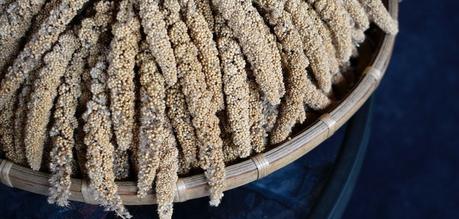
Millet, also known as Panicum miliaceum, is in the family of grasses and has been used to make flour for thousands of years. It's estimated that the grain originated in Africa but now can be found throughout the world.
What is millet?
Millet is a cereal grain used as human food and animal feed. It has been grown for millennia in Asia, Africa, the Americas, Europe and the Middle East. The most commonly consumed variety of millet is African millet (Pennisetum glaucum), which was originally domesticated in West Africa.
However, it's unclear when exactly this type of millet was first cultivated on that continent. Some studies suggest that African millet may have originated in Ethiopia or Sudan at least 2,000 years ago.
In any case, its spread across northern Africa is well documented by historical sources. During the colonial era, European traders introduced millet to other parts of Africa and Asia where it now grows widely.
Types of millet:
Millet is a type of cereal grain that has been consumed for thousands of years. It's grown in China, Africa, India and the Middle East. There are four different types of millet:
- Pearl millet: It has a mild flavor but can be bland depending on how it's prepared or stored.
- Finger millet: This millet is light-colored with a nutty flavor that can be used as an alternative to rice or quinoa.
- Proso millet: Proso millet has a higher protein content than any other type of millet and can also be substituted for rice.
- Foxtail millet: This type of millet is similar to proso but contains less protein.
Is millet good for your health?
Millet has a low glycemic index, which means it can be used to stabilize blood sugar levels. It also contains good amounts of magnesium, phosphorus, potassium, calcium, and manganese. However, millet should be eaten in moderation.
Also, millet flour does not have any leavening properties so it cannot be used for yeast breads. But this grain can be made into a delicious porridge or added to soups and stews.
Millet is the perfect choice for people who are sensitive to the high levels of gluten found in wheat and rye but want something that still offers many health benefits. Millet's mild flavor makes it easy to incorporate into many recipes without sacrificing taste!
Millet nutrition value:
Per 100 g serving of cooked millet contains:
- Calories: 119
- Carbohydrates: 23.7 g
- Protein: 3.5 g
- Calcium: 3 mg
- Iron: 0.6 mg
- Magnesium: 44 mg
- Phosphrus: 100 mg
- Potassium: 62 mg
- Vitamin A: 3 IU
- Vitamin K: 0.3 mcg
- Thiamin: 0.1 mg
- Riboflavin: 0.1 mg
- Niacin: 1.3 mg
- Vitamin B6: 0.1 mg
- Folate: 19 mcg
- Choline: 11.2 mg
- Sodium: 2 mg
- Zinc: 0.9 mg
- Copper: 0.2 mg
- Manganese: 0.3 mg
- Selenium: 0.9 mcg
Health benefits of millet:
Millet has many benefits because it's high in fiber and protein. It may not taste like traditional grains but most people find that millet has a nice nutty flavor once they get used to it. However, many people don't realize just how good millet can be for your health. Read on to discover 8 amazing health benefits that come from eating this nutritious seed.
1. Millet is a whole grain:
Millet is a whole grain that provides many health benefits, including the following:
- It is low in fat and cholesterol but high in fiber.
- It has a low glycemic index.
- It does not contain gluten and therefore can be consumed by people with gluten sensitivities or celiac disease.
- It contains five essential amino acids which are often lacking in plant-based diets.
- It also contains nutrients such as manganese, phosphorus, magnesium, iron and calcium.
- It's an excellent food for diabetics due to its ability to lower blood sugar levels.
2. Millet is packed with nutrients:
Millet is one of the most important staple crops in Asia, Africa and Latin America. It has a high nutrient density, including protein, fiber, minerals, vitamins and fatty acids.
Magnesium present in millet can help prevent heart disease by regulating blood pressure levels. Magnesium also helps reduce inflammation caused by arthritis or allergies with its anti-inflammatory effect. It also contains lysine, an essential amino acid that builds immunity by creating antibodies and fighting viruses.
3. Millet can help you lose weight:
Millet has a low calorie count, making it a great choice for those who are looking to lose weight. It also helps boost your metabolism and keeps you feeling fuller longer.
For these reasons and more, millet is one of the best grains you can add to your diet. It's high in fiber, which is important for heart health, but won't make you feel bloated or gassy. You'll find that this food will keep hunger at bay much better than other foods as well!
4. Millet can help lower cholesterol:
Millet has been shown to lower cholesterol levels by as much as 20% in six weeks. Additionally, millet is a great source of protein and fiber, which can help you feel fuller for longer periods of time. If you are looking for a gluten-free alternative to wheat, try millet!
Millet also contains more vitamin B1 than any other grain and it also contains plenty of magnesium, phosphorus, potassium and manganese. So if you're looking for something new to add to your diet or just an awesome side dish - give this ancient grain a try!
5. Millet can help control blood sugar:
Millet is a great alternative to grains such as rice, wheat, and corn because it has a low glycemic index. This means that it won't spike your blood sugar levels like other grains.
In fact, eating millet can even help control your blood sugar levels better than whole wheat or brown rice. It helps keep the digestive tract healthy. The seed is gluten-free which makes it easier for people with celiac disease to enjoy it.
6. Millet can boost heart health:
Millet is a whole grain that can boost heart health and help lower cholesterol levels. It's also a great source of fiber, which helps keep your digestive system on track and aids in weight management.
Studies show that eating millet can also reduce the risk for type-2 diabetes, as it slows down the rate at which sugar is absorbed into the bloodstream. If you're looking to get more protein in your diet, millet has it too!
7. Millet is also an excellent source of protein:
In addition to being rich in fiber and other nutrients, millet is also an excellent source of protein. One cup provides 8 grams! Millet can be used as a gluten-free flour substitute or if you just want to avoid eating too much refined carbohydrates.
8. Millet may help prevent cancer:
Millet may help prevent cancer, according to a study from the University of Buffalo. The study found that mice who were fed millet were two times less likely to develop colon cancer than those in the control group.
The researchers also discovered that millet helped slow down tumor growth and improved the overall health of mice. These findings suggest that it could be beneficial for people at risk of developing colorectal cancer to include more millet in their diet.
Is millet gluten free?
Millet is a gluten-free grain that comes from a type of grass. It's been around for centuries, but has grown in popularity recently because of its many health benefits. It's also high in protein, which makes it an excellent food for those following a vegetarian or vegan diet.
However, millet does have some downsides to it as well. For example, it can be hard on the stomach due to its high fiber content if you aren't used to eating it regularly.
What is millet used for?
Millet is a type of cereal grain that was originally grown in China and India, but has now spread to other parts of the world. It is most commonly used for porridge or as an ingredient in flour for breads and cakes.
In addition to its use in food, millet can also be used as livestock feed due to its high nutritional value. Millet can be added to soups, salads, stews, curries and casseroles.
How to cook millet?
Millet is a gluten-free cereal grain that's packed with vitamins, minerals, protein, fiber and more. It has a light flavor that's slightly sweet, so it pairs well in savory dishes like pilafs or as an alternative to rice in dishes like risotto. It can also be used to make breakfast cereals or porridges.
To cook millet, you'll want to follow the cooking instructions on the package of your specific variety. Generally, you'll want to use two parts water for every one part millet. Bring the water to a boil and add the millet. Bring the mixture back up to boiling before reducing heat and simmering until all of the liquid has been absorbed by the grains (usually 15 minutes). The result is a fluffy, wholesome dish full of nutrition.
Side effects of millet:
Some people experience digestive discomfort when eating millet due to its high levels of phytic acid and goitrogens.
Phytic acid can bind to minerals like calcium, iron and zinc in the intestine, which may lead to deficiencies if consumed excessively. Goitrogens interfere with thyroid function by interfering with iodine uptake, which may cause hypothyroidism.
Although these potential issues shouldn't deter anyone from enjoying this nutritious food staple, it's important to keep them in mind when choosing how much and how often you consume millet.
Conclusion
Eating whole grains like millet helps reduce the risk of heart disease by lowering bad cholesterol levels. Research indicates that if you eat more than 3 servings of whole grains per day, you are up to 30% less likely to develop diabetes than someone who eats 1-3 servings per day.
In addition, millet does have some side effects if you consume too much of it or don't do enough research beforehand. If you want to try millet, be sure to talk with your doctor first!

